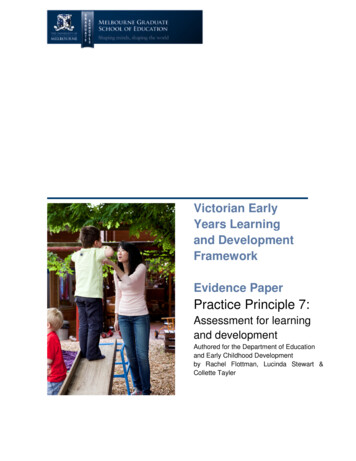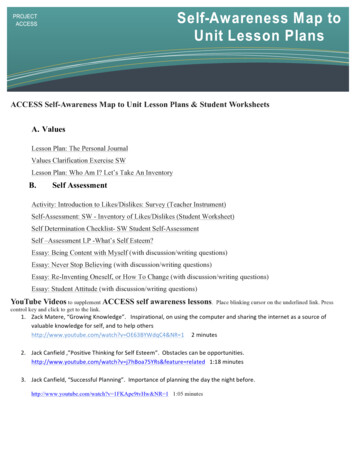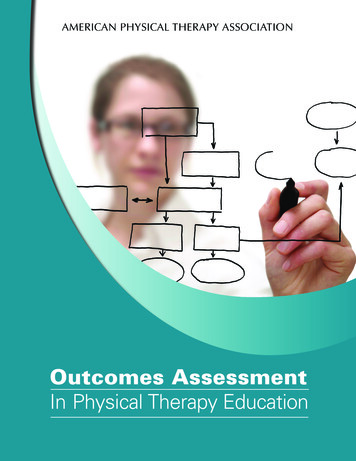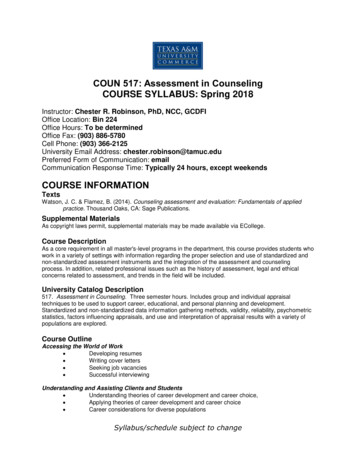
Transcription
TVictorian EarlyYears Learningand DevelopmentFrameworkEvidence PaperPractice Principle 7:Assessment for learningand developmentAuthored for the Department of Educationand Early Childhood Developmentby Rachel Flottman, Lucinda Stewart &Collette Tayler
Practice Principle 7: Assessment for learning and developmentThe Victorian Early Years Learning and Development Framework guides earlychildhood professionals’ practice in Victoria. The Victorian Framework identifieseight Practice Principles for Learning and Development (Practice Principles). ThePractice Principles are based on the P-12 Principles of Learning and Teaching, thepedagogy from the national Early Years Learning Framework, and are informed bythe latest research.The Practice Principles are interrelated and designed to inform each other. Theyare categorised as Collaborative, Effective and Reflective:Collaborative1. Family-centred practice2. Partnerships with professionals3. High expectations for every childEffective4. Equity and diversity5. Respectful relationships and responsive engagement6. Integrated teaching and learning approaches7. Assessment for learning and developmentReflective8. Reflective practiceThese Evidence Papers document the research that underpins each PracticePrinciple. The content of the Evidence Papers will be developed into a series ofpractical guides – Practice Principles in Practice – that will provide practical adviceto early childhood professionals on how to align their practice to the PracticePrinciples.2
Practice Principle 7: Assessment for learning and developmentContentsExecutive Summary . 4Introduction . 6What do we mean by ‘assessment for learning and development’? . 7Why is assessment important in early childhood learning and development? . 8Assessment as learning helps to make children’s learning visible to themselves .9The process of assessment can empower families as key agents in their child’slearning .9How do we achieve best practice? . 10Effective assessment values cultural perspectives of children’s learning . 10Effective assessment incorporates children’s views on their learning. 10Effective assessment takes families’ perspectives into account . 11Effective assessment is meaningful for children when it is authentic . 11Effective assessment uses multiple approaches that are appropriate for each child’scompetency. 12Multiple that assessments occur over time and are holistic contribute to a completepicture of each child . 13Professionals take objective, non-judgemental and accurate assessments of children’slearning and development. 14Implications for achieving the best outcomes for children. 15Methodology . 17References . 183
Executive SummaryThe Victorian Early Years Learning and Development Framework (2009)recognises the importance of early childhood professionals undertakingassessment as a core part of effective practice. Early childhood professionals assesschildren’s learning and development to develop a strong understanding of eachchild’s strengths, abilities and interests. The information that professionals collectand analyse through the assessment process informs the decisions they make toadvance children’s learning and development.Early childhood professionals approach assessment in different ways. Earlychildhood educators routinely take observations to better understand children’sstrengths, abilities and interests. Maternal and Child Health nurses undertakeassessments of children’s health and development according to the Key Age andStage Framework. Allied health professionals working in early childhoodintervention services use a range of professional and clinical assessment tools toidentify children’s strengths and design programs that best support each child’slearning and development.Assessment practice can be arranged into three categories: assessment forlearning; assessment of learning and assessment as learning . Assessment forlearning involves professionals analysing data about the child’s strengths, abilitiesand interests and making inferences from it which assists them to make decisionsabout programs for children every day. Assessment for learning is identified in theliterature as essential to improving outcomes for young children. Assessment oflearning assists professionals to develop a picture of each child’s strengths, abilitiesand interests at a point in time. Finally, assessment as learning occurs wheninformation about children’s own learning and development progress is providedto them as feedback on their learning activity. Assessment as learning is identifiedin the literature as important in supporting children’s self-efficacy and self-esteem.Effective assessment is responsive to individual children. That is, it involves toolsand approaches that are appropriate to individual children and are undertaken insettings familiar to them. They must also be undertaken regularly and multipletimes to ensure a more accurate picture is generated at a point in time, but also sothat growth and progress are captured. Importantly, as children are activeparticipants in their own learning and families are experts on their own children,effective assessment processes must include children and families’ views oflearning, as well as other professionals’ views as appropriate.The implications for practice informed by the research and detailed in this Paperare:
Early childhood professionals require the knowledge and skills to undertakenon-judgemental assessments of children’s learning and developmentAssessment needs to be undertaken collaboratively with children, familiesand professionalsA culture of evidence-based program and practice decisions must bepromotedEffective assessment is dynamic and ongoing, just as children’s learning anddevelopment is dynamicA systematic and rigorous approach is needed to support systematicassessment of children’s learning and development across services5
IntroductionThe Victorian Early Years Learning and Development Framework recognises theimportance of early childhood professionals assessing children’s learning anddevelopment to provide essential information about a child’s abilities, interests andculture to inform their practice and program decision-making. It states that:Assessment is designed to discover what children know and understand, based onwhat they make, write, draw, say and do. Early childhood professionals assess theprogress of children’s learning and development, what children are ready to learnand how they can be supported.All children benefit when assessment reflects a whole-child approach, providing anholistic view of learning and development. Early childhood professionals use arange of assessment tools, processes and approaches to build on prior learning,avoid duplication and add value. Early childhood professionals understand thatfamilies play a vital role in their children’s learning and development.Early childhood professionals are aware of the health and wellbeing of the familywhen planning for the child’s learning and development. Early childhoodprofessionals assess children’s learning in ways that: inform their practice include children’s views of their own learning are authentic and responsive to how children demonstrate their learning anddevelopment draw on families’ perspectives, knowledge, experiences and expectations consider children in the context of their families and provide support tofamilies when necessary value the culturally specific knowledge embedded within communities aboutchildren’s learning and development are transparent and objective, and provide families with information abouttheir children’s learning and development, and about what they can do tofurther support their children gather and analyse information from a wide range of sources to help themassess and plan effectively provide the best possible advice and guidance to children and their families.(VEYLDF p. 13)Assessment in early childhood is not a new practice. Early childhood professionalsuse a range of assessment tools to identify children’s interactions, conversations,ideas and expressions in order to better understand each child’s strengths, abilities6
and interests. Early childhood educators often use observation techniques torecord children’s learning. Allied health professionals, such as maternal and childhealth nurses and early intervention professionals, are experienced at using clinicalassessment tools to understand a child’s capabilities and possible development andhealth needs, also with the view to designing a program of support to promote thatchild’s learning and development.Recent evidence reinforces the effectiveness of objective and systematicassessments of children’s learning and development undertaken by early childhoodprofessionals in order to inform responsive programs that support children’slearning and development.This Evidence Paper explores research related to assessment practice in thecontext of early childhood services. Specifically it will describe why assessment isan important feature of effective practice; how early childhood professionals canintegrate assessment into their daily work with children; and what the implicationsof the research are for practice.What do we mean by ‘assessment for learning and development’?Assessment practice in education and care can be arranged into three categories:assessment of learning and development; assessment for learning and developmentand assessment as learning.Assessment of learning and development is the most common form of assessment.This is assessment of a child’s learning at a particular point in time, and thatsummarises all of the learning and development that has preceded it (Taras, 2005).This kind of assessment can be large-scale assessment in a particular field, such asthe National Assessment Program – Literacy and Numeracy (NAPLAN), in which anentire population of children is assessed using a common assessment tool. It canalso be a small scale assessment within an individual early childhood setting withthe purpose of clarifying a child’s learning in order to report that learning tofamilies (Earl, 2003) – for example, Transition Learning and DevelopmentStatements.Assessment for learning and development refers to the formative assessment thattakes place in order for decisions to be made to inform the next stage of learning(Earl, 2003). As assessment for learning informs program planning decisions aboutindividual children, assessments need to be taken on an ongoing and individualbasis. Assessment for learning assists early childhood professionals to makedecisions about learning programs for children every day and is identified in theliterature as essential for improving outcomes for children.7
Within the formative assessment process, early childhood professionals gatherevidence of children’s learning and development, based on what they write, draw,make, say and do. They analyse this evidence and make inferences from it byapplying their knowledge of child development theory, the child’s social andcultural background and their knowledge of the five Learning and DevelopmentOutcomes in the curriculum frameworks (VEYLDF, Early Years LearningFramework, My Time Our Place: Framework for School Age Care). They alsodiscuss their interpretation with the child and the child’s family, as well as otherprofessionals when appropriate, to develop a strong picture of the child’s strengths,abilities and interests. Early childhood professionals then use this information todesign effective programs for children that are responsive and evidence-based(Hattie, 2009).Assessment as learning and development occurs when the child is involved in theassessment process. Through this process the child has the opportunity to monitorwhat they are learning and use feedback to make adjustments to theirunderstandings (Earl, 2003). Assessment as learning is linked to higher levels ofself-efficacy in children as they see a reward for their learning effort (OECD/ CERI,2008).Assessment practice can be both formal and informal. Formal assessments typicallyinvolve reliable and valid standardised testing (Brown and Rolfe, 2005). Informalassessments, on the other hand include non-standardised testing and theperformance on these assessments is not compared with other children (Brownand Rolfe, 2005). They typically include interviews with children and worksampling, and observation techniques such as running records, anecdotal records,checklists, rating scales and event and time sampling (MacNaughton, Rolfe andSiraj-Blatchford, 2010; NAEYC, 2009). All of these assessment tools are designed togather information about the progress of children’s learning and development(Mindes, 2003) and are used to make children’s learning and development visible(Tayler, et al., 2008).Why is assessment important in early childhood learning anddevelopment?It is now recognised that age alone is not an adequate indicator of a child’s skill orcapability. There is substantial evidence of the large degree of variation betweenindividual children’s cognitive, social and emotional functioning and the impact ofchildren’s culture and environment on their knowledge, skills and understandings(Brainerd, 1978; Feldman, 1980; Raban et al., 2007). Early childhood professionals,therefore, cannot simply rely on children’s age to determine their capabilities andmake appropriate and responsive program decisions. It is for this reason thatassessment is so important. Through the process of assessment, professionals8
collect evidence of each child’s learning and development and analyse and interpretit to make program and intervention decisions for extending the child’s learningand development in the future (Bagnato, 2010).Within this broad rationale for assessment in early childhood, the literatureidentifies a range of specific purposes of assessment: monitoring children’slearning and development progress; making decisions about programs to advancelearning and development; identifying children who may benefit from specialsupport or intervention; communicating a child’s learning and development withfamilies and other professionals; involving families in planning children’s learningin a meaningful way; and evaluating program effectiveness; (Appl, 2000; Bagnato,2010; Beaty, 2002; Copple and Bredekamp 2006).Assessment as learning helps to make children’s learning visible to themselvesThe evidence of children’s learning gathered through the assessment process canbe used powerfully to communicate and make children’s own learning visible tothem (Carr, 2001). This is useful in promoting children’s own self-efficacy – that is,belief in their own ability to take actions that will achieve their goals – as they cansee returns and progress for their learning efforts (Uszynska-Jarmoc, 2007).Assessment also supports collaborative practice with children to set challenginglearning goals. In this way, assessment is not a one-way process whereby childrenlearn and early childhood professionals assess, but is a dynamic process throughwhich professionals and children learn, analyse and adapt (Kozulin and Falik,1995).The process of assessment can empower families as key agents in their child’slearningEarly childhood professionals routinely work in partnership with children’sfamilies and provide valuable information to them about their child’s learning anddevelopment (Brown and Bortoli, 2010). Families are in a unique position toprovide understanding and evidence of their own children’s learning abilities(Alasuutari, 2010). The information early childhood professionals collect throughthe assessment process can also be translated to families to communicate theprogress of their child’s learning and development (NAEYC, 2009), and supportfamilies to build on that learning. Puckett and Black (2008) and Snow and VanHelem (2008) support this, suggesting that assessments that determine theindividual strengths and needs of children are particularly useful for families.9
How do we achieve best practice?Effective assessment values cultural perspectives of children’s learningChildren’s learning and development is informed by their culture, values andexperiences. Moreover, cultural background and language significantly influencethe knowledge and vocabulary children have developed. Cultural background andlanguage also frame how, and upon what, children can be appropriately assessed(Gullo, 2005). Professionals therefore need to be aware of children and theirfamily’s cultural context. On this basis Appl (2000) suggests that approaches usedfor assessing children need to be culturally sensitive and interesting to children.Using assessment tools that are culturally, linguistically and developmentallyappropriate assists the assessment process to be authentic. Further, theassessment process is facilitated when children’s interests and daily activities arethe base for collecting relevant evidence of the child’s learning (Baldwin et al.,2009; Gullo 2005). It is also important that professionals take account of children’scultural context when analysing and interpreting the assessment data, so that anaccurate picture is developed.Effective assessment incorporates children’s views on their learningThe Early Years Learning Framework advocates that children are activeparticipants in their own learning (DEEWR, 2009). It is important, therefore, thatchildren are given the opportunity to actively contribute to assessments of theirlearning and receive feedback on their learning (Seitz and Bartholomew, 2008).There are a number of ways that children’s participation can be facilitated.Shared sustained thinking can provide opportunities for incorporating children’sviews on their learning into formative assessment. Shared sustained thinking is anopen-ended context for exploratory learning in which ‘two or more individuals‘work together’ in an intellectual way to solve a problem, clarify a concept, evaluateactivities, or extend a narrative’ (Sylva et al., 2010). When children describe,explain and justify their thinking to others in shared sustained thinking, theydevelop meta-cognition and ‘learn to learn’ (Siraj-Blatchford, 2009). Sharedsustained thinking provides opportunities for formative assessment because itenables early childhood professionals to build an understanding of children’slearning in order to make curriculum decisions.Research also indicates that effective assessment involves children having the timeto express their opinions about what is recorded about their learning (Glazzard etal., 2010). According to the NAEYC (2009) children’s own evaluations of their workare an important part of their individual assessment.10
Other research suggests that there is great value in the feedback children receiveon their own learning through the assessment process. Puckett and Black (2008)suggest that early childhood professionals should assist children to reflect on theirown learning as well as assist them to set individual goals. Tayler and colleagues(2008) agree that children have the capacity not only to monitor their ownprogress but to form goals and shape their own future learning. Through feedbackand interactions children are able to self-assess and form views about themselvesas an effective learner (Tayler et al., 2008).Effective assessment takes families’ perspectives into accountFamilies play an essential role in their child’s learning and development and are avaluable source of information about their children (Baldwin et al., 2009; Gullo,2005; Wortham, 2008). Family’s perspectives are particularly useful in providinginformation regarding a child’s history, culture, disposition and abilities in differentsettings (Brink, 2002). They can also provide information about children’sbehaviour and learning in different settings. This is important with very youngchildren, particularly in relation to temperament and behaviour (Neisworth andBagnato, 2004). Including and valuing family perspectives in assessment, therefore,is a key feature of effective assessment (Glazzard et al., 2010, Grisham-Brown et al.,2006). This helps to develop the most accurate image of each child (Brink, 2002;Wortham, 2008). Further emphasising the importance of family’s involvement inthe assessment process is the clear evidence that family involvement in theirchildren’s education has a positive impact on their children’s overall learning anddevelopment (Beaty, 2002).Building effective partnerships often requires early childhood professionals toinitiate and promote connections and relationships with families. They can do thisby reflecting on how much they value the contribution of parents to assessmentand whether they consider parents as partners in children’s education (Glazzard etal., 2010). Early childhood professionals who genuinely seek to understandfamilies’ perspectives about learning and their children are better prepared to beresponsive within the family-professional collaboration (Puckett and Black, 2008).Carr and Harris (2001) support this view, suggesting that the best educationalclimate is collaborative. See Evidence Paper 1: Family-Centred Practice for moreinformation on working collaboratively with families.Effective assessment is meaningful for children when it is authenticAssessments are most accurate and meaningful for children when they areconducted in the child’s natural environment, are part of everyday learningexperiences, and when they provide opportunities for feedback along the way(Hatch, 2010; Grisham-Brown et al., 2006). Authentic assessments capturechildren’s competencies and incremental developments in their skills (Baldwin et11
al., 2009). Glazzard and colleagues (2010) agree that assessing children based onobservations in their environment through independent learning and adultdirected learning is an effective assessment process for developing acomprehensive picture of the child’s capabilities.Authentic assessments provide an opportunity for assessment that is free of theadult’s own agenda. They are conducted in a variety of contexts such as home andcare settings where children are familiar and comfortable in the environment(Losardo and Notari-Syverson, 2001) and are able to use familiar materials that areof interest to them. This helps to facilitate and maintain children’s ownparticipation in the assessment (Losardo and Notari-Syverson, 2001). This form ofassessment is also effective because it provides children with opportunities todemonstrate their skills across the various developmental domains and varyingcontexts (Losardo and Notari-Syverson, 2001). This contributes to more accurateassessment. Children’s abilities are best displayed in environments where the childis most comfortable, providing familiarity while giving attention to culturallyappropriate materials (Losard and Notari-Syverson, 2001).Making assessment meaningful for children involves using tools that areappropriate for the child to use (Copple and Bredekamp, 2006). This includesmeasures which allow for the full range of children’s competencies to be recorded(Bagnato, 2007). Essentially, using measures that children are interested in is thebest approach to assessment and will yield the most valid information (Copple andBredekamp, 2006). Using informal measures that do not significantly interferewith children’s normal environments and movements is most likely to reflectchildren’s full capabilities and understandings (Copple and Bredekamp, 2006).Effective assessment uses multiple approaches that are appropriate for each child’scompetencyChildren learn and demonstrate their learning in many ways, and should thereforebe observed using a variety of tools and approaches and in a variety of contexts(Gullo, 2005). The NAEYC (2009) states that assessment is most effective whenmultiple methods are used to gather reliable and appropriate information about achild’s learning and development (NAEYC, 2009). There is wide consensus in theresearch literature that a variety of formal and informal assessment tools give earlychildhood professionals and families a comprehensive view of children’s learningand development (Brown and Rolfe, 2005; Glazzard et al., 2010; Grisham-Brown etal., 2006; Wortham, 2008). Moreover, Rinaldi (2006) suggests that when educatorsand families combine their shared understandings, new understandings emergethat would not be possible from separate perspectives.12
Hatch (2010) suggests that dynamic assessments enable effective assessment ofyoung children. Dynamic assessment involves assessing what children are capableof doing independently as well as what they can do with the assistance of an adult.This creates a direct link between the teaching and assessment process (Hatch,2010). With this in mind, assessments should be context and age appropriate, butthey should also recognise the current capabilities (Gullo, 2005) and culture (Fleer,2002) of each child. Copple and Bredekamp (2006) agree, stating that ageappropriateness combined with assessments across different situations andsettings are likely to ensure more effective assessment practice. Recognising theidiosyncratic nature of learning, Puckett and Black (2008) also suggest thatchildren should only be compared to their own developmental trajectory ratherthan compared to the average behaviour for a group.Multiple that assessments occur over time and are holistic contribute to a completepicture of each childAssessment for learning and development needs to take place continually, in morethan one activity or setting, in order to generate a more accurate picture of eachchild’s abilities. This allows for the dynamic and ongoing nature of children’slearning, but also recognises that children will behave in different ways, in differentcontexts and on different days (Sattler, 1998). By gathering data across a period oftime, early childhood professionals gather a complete picture of each child’scapabilities and record change and growth over time (Allen, 2007). By collectingthese data as they occur over time, early childhood professionals can later applytheir professional knowledge to analyse the evidence to create a detailed picture ofthe child’s capabilities (Bagnato, 2007). From this rich source of evidence,professionals can make accurate inferences about each child’s capabilities and theirrate of learning and development. These inferences can serve to inform anevidence-based program that advances each child’s learning and development.Gullo (2005) states the need for continual and comprehensive (or holistic)assessment. Continual assessment occurs when children are assessed over timewith the view of tracking their progress. Baldwin, Adams and Kelly (2009) highlightthe importance of continual assessment for the purposes of making decisions aboutindividual development, learning programs and further assessment. Copple andBredekamp (2006) agree that ongoing assessment of children’ progress is centralto planning and helps early childhood professionals to know the children withwhom they work.Holistic assessment allows early childhood professionals to explore and assess themany aspects of children’s learning and development in different contexts,environments and relationships. Holistic assessment enables professionals to13
develop a strong picture of the child’s learning and development across all outcomeareas.Professionals take objective, non-judgemental and accurate assessments of children’slearning and developmentTo be effective in gathering evidence of children’s learning and development, earlychildhood professionals need to be effective, accurate and informed observers(Mindes, 2003). It is important that the evidence collected through various forms ofassessment reflects each child’s abilities, and how they approach learning, as wellas the outcomes of their efforts (Puckett and Black, 2008). Early childhoodprofessionals, therefore, must be able to effectively observe children, choose thebest method to record these observations and apply their professional expertise tointerpret this evidence of learning and development (Mindes, 2003). Theobservation skills of early childhood professionals are essential in providing a basefor a supported and responsive curriculum (Baldwin et al., 2009); this includes theability to critically reflect on the methods of observation (MacNaughton, 2003).14
Implications for achieving the best outcomes for children1. Early childhood professionals require the knowledge and skills toundertake non-judgemental assessmentAlthough early childhood professionals, in particular educators, are experienced attaking obs
Executive Summary The Victorian Early Years Learning and Development Framework (2009) recognises the importance of early childhood professionals undertaking assessment as a core part of effective practice. Early childhood professionals assess children's learning and development to develop a strong understanding of each











